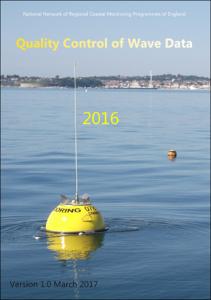| dc.contributor.author | Mason, Travis | |
| dc.contributor.author | Dhoop, Thomas | |
| dc.date.accessioned | 2021-06-29T17:27:04Z | |
| dc.date.available | 2021-06-29T17:27:04Z | |
| dc.date.issued | 2017 | |
| dc.identifier.citation | Morris, T. and Droop, T. (2017) Quality Control of Wave Data 2016, Version 1.0.01. Southampton, UK, Channel Coastal Observatory, 11pp. DOI: http://dx.doi.org/10.25607/OBP-1230 | en_US |
| dc.identifier.uri | https://repository.oceanbestpractices.org/handle/11329/1598 | |
| dc.identifier.uri | http://dx.doi.org/10.25607/OBP-1230 | |
| dc.description.abstract | The National Network of Regional Coastal Monitoring Programmes of England has developed a coastal
wave network which concentrates on measurements in shallow water where, traditionally, there are
very few long-term wave data and where the wave transformation models are generally less reliable.
The main purposes of the coastal wave network are to:
- Provide real-time data for use in beach operations, coastal flood forecasting and warning
- Provide baseline design statistics for future coastal and marine planning projects
- Enable operational assistance in coastal construction projects
- Assist the monitoring of coastal processes such as beach erosion and sediment transport
- Provide validation of coastal wave hydrodynamics and sediment dynamics modelling
Quality assurance (QA) and quality control (QC) practices are in place to provide high-quality marine
observations and to ensure the value and credibility of the data to users. Quality Assurance concerns
aspects such as the choice of equipment suitable for the environment, sufficiently accurate, precise
and reliable with adequate resolution, and subsequent operational maintenance, which together can
ensure high quality observations in the long term. Quality Control refers to the subsequent steps
taken to review the measured data using both automated and manual techniques.
There is no worldwide or European standard for wave data. This document outlines the QA practices
and QC tests used for wave data collected by the Regional Coastal Monitoring Programmes.
The following wave parameters are collected and archived:
- Significant wave height HS (m)
- Spectrally-derived zero-crossing wave period TZ (s)
- Peak wave period TP (s)
- Wave direction Dir (°)
- (Directional) Spread Spd (°)
- Maximum observed wave height Hmax (m)
- Sea surface temperature SST (C°) | en_US |
| dc.description.sponsorship | National Network of Regional Coastal Monitoring Programmes of England | en_US |
| dc.language.iso | en | en_US |
| dc.publisher | Channel Coastal Observatory, National Oceanography Centre | en_US |
| dc.title | Quality Assurance & Quality Control of Wave Data 2016, Version 1.0.01. | en_US |
| dc.type | Report | en_US |
| dc.description.status | Published | en_US |
| dc.format.pages | 11pp | en_US |
| dc.description.refereed | Refereed | en_US |
| dc.publisher.place | Southampton UK | en_US |
| dc.subject.parameterDiscipline | Waves | en_US |
| dc.subject.instrumentType | wave recorders | en_US |
| dc.subject.dmProcesses | Data acquisition | en_US |
| dc.subject.dmProcesses | Data quality control | en_US |
| dc.subject.dmProcesses | Data processing | en_US |
| dc.description.currentstatus | Current | en_US |
| dc.description.sdg | 14.a | en_US |
| dc.description.eov | Sea state | en_US |
| dc.description.adoption | Multi-organisational | en_US |
| dc.description.sensors | Directional Waverider buoys, Datawell | en_US |
| dc.description.methodologyType | Method | en_US |
| dc.description.methodologyType | Specification of criteria | en_US |
| obps.endorsementAuthorDeclared.recommendedPractice | National Network of Regional Coastal Monitoring Programmes of England | |
| obps.contact.contactemail | cco@channelcoast.org | |
| obps.resourceurl.publisher | https://coastalmonitoring.org/ccoresources/dataqualitycontrol/QC_Manual_CCO_Waves.pdf | |
 Repository of community practices in Ocean Research, Applications and Data/Information Management
Repository of community practices in Ocean Research, Applications and Data/Information Management
